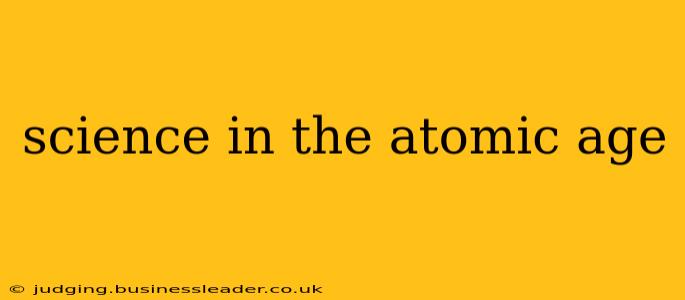The Atomic Age, ushered in by the Manhattan Project and the bombings of Hiroshima and Nagasaki, irrevocably altered the course of human history. It wasn't just about the devastating power of nuclear weapons; it marked a profound shift in our understanding of the universe and our place within it. This era witnessed unprecedented scientific advancements, fueling both incredible progress and profound ethical dilemmas that continue to shape our world today. This exploration delves into the key scientific developments of the Atomic Age, the ethical considerations they raised, and their lasting impact on society.
What are the key scientific advancements of the Atomic Age?
The Atomic Age spurred a surge in scientific exploration across numerous fields. The most obvious advancement was nuclear physics itself. The splitting of the atom revealed the immense energy locked within matter, leading to the development of nuclear power and, tragically, nuclear weapons. Beyond nuclear physics, however, the era saw significant progress in:
- Particle Physics: The quest to understand the fundamental building blocks of matter intensified. New particles were discovered, and theories like quantum electrodynamics were refined, leading to a deeper understanding of the universe at its most basic level.
- Materials Science: The development of new materials, often driven by the demands of the nuclear industry, revolutionized various fields. Advanced alloys, plastics, and ceramics emerged, finding applications in everything from aerospace to medicine.
- Electronics and Computing: The need to process vast amounts of data related to nuclear research propelled advancements in electronics and computing. The development of transistors and early computers laid the groundwork for the digital revolution.
- Medicine: Radioisotopes, a byproduct of nuclear research, found widespread use in medical diagnostics and treatment, revolutionizing areas like cancer therapy and imaging techniques.
What were the ethical dilemmas raised by scientific advancements in the Atomic Age?
The immense power unleashed by atomic science presented profound ethical challenges. The creation of nuclear weapons raised questions about:
- The Morality of Mass Destruction: The potential for unprecedented devastation forced a global reckoning with the ethics of warfare and the responsibility of scientists in developing such powerful weapons.
- Nuclear Proliferation: The spread of nuclear technology raised concerns about the risk of accidental or intentional use, escalating international tensions and the threat of global conflict.
- Environmental Concerns: The long-term effects of nuclear testing and accidents on the environment and human health sparked debates about environmental responsibility and the long-term consequences of technological advancement.
How did the Atomic Age change the relationship between science and society?
The Atomic Age fundamentally altered the relationship between science and society. The public became more aware of the potential benefits and risks of scientific progress. This led to increased government regulation of scientific research and a heightened awareness of the social and ethical implications of technological advancements. The creation of government-funded research institutions like national laboratories became commonplace, blurring the lines between scientific research and national security.
What are some examples of scientific breakthroughs in the Atomic Age that impacted everyday life?
Many breakthroughs initially developed for military or research purposes eventually found their way into everyday life. For example:
- Nuclear Medicine: Radioisotopes are routinely used in medical imaging (PET scans) and cancer treatment (radiotherapy).
- Nuclear Power: Nuclear power plants provide a significant source of electricity in many countries.
- Aerospace Technology: Materials science advancements spurred by the space race led to the development of lighter and stronger materials used in airplanes and other technologies.
- Computer Technology: Advancements in computing, initially driven by nuclear research, have revolutionized communication, information processing, and countless other aspects of modern life.
What are the long-term effects of the Atomic Age on science and society?
The legacy of the Atomic Age is complex and multifaceted. The ethical dilemmas it raised continue to resonate today, prompting ongoing discussions about responsible innovation and the societal implications of technological advancements. The scientific breakthroughs of this era continue to shape modern life, while the threat of nuclear weapons remains a stark reminder of the responsibility that comes with scientific progress. The Atomic Age serves as a cautionary tale and a testament to the transformative power of science, highlighting the urgent need for ethical reflection and responsible stewardship of technological innovation.
